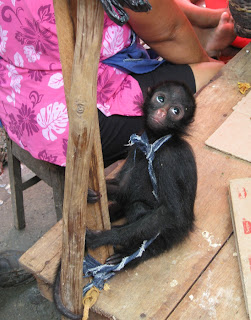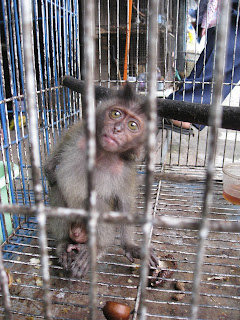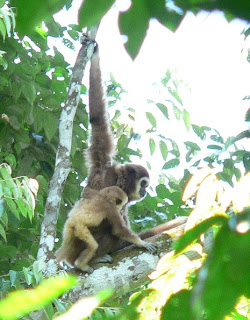When I tell her what to do, in order to prevent failure, she usually gets upset and loses interest in the activity. But when I let her figure it out on her own, she feels accomplished and proud. Working through failure increases learning at all stages of life and is necessary to really learn from success.
by Sara Kate KneidelThursday, March 31, 2011
Failure is a part of success
In this video Michael Goodwin proposes that without failure, success loses its meaning. I've certainly heard this message for years from my father, who is a high school biology teacher. Over the 25 years he's spent at his school, I've heard him rant countless times about pressure from parents and even school administrators to award As and Bs to all his students - even those who haven't earned them - so they'll have good-looking transcripts for college. The result of this, he points out, is that those grades become meaningless. And what's more, the grading system is no longer a motivation for students to succeed. Why offer grades at all if they're all the same? Furthermore, I'd argue that this issue starts long before the classroom. When I'm playing with my housemates' two-year-old, I frequently feel compelled to intervene before she does somethin g silly. "You can't fit your dolls into that box! It's too small." "You can't wear that shoe! It's too big for you." But I try to restrain myself from offering these comments. She learns much faster from trying - and failing - to do these things than she does if I tell her what to do. Yesterday I watched her trying to make a tower out of a set of nesting plastic cups. She didn't understand that she had to stack the cups according to size in order to make a tower. But I said nothing and watched her try and try. She gradually observed that if she put a small cup first, the larger cups just covered it up. After several minutes of trying she rearranged the cups and successfully built a tower!
g silly. "You can't fit your dolls into that box! It's too small." "You can't wear that shoe! It's too big for you." But I try to restrain myself from offering these comments. She learns much faster from trying - and failing - to do these things than she does if I tell her what to do. Yesterday I watched her trying to make a tower out of a set of nesting plastic cups. She didn't understand that she had to stack the cups according to size in order to make a tower. But I said nothing and watched her try and try. She gradually observed that if she put a small cup first, the larger cups just covered it up. After several minutes of trying she rearranged the cups and successfully built a tower!
Monday, March 21, 2011
Trade a major threat to primate survival
Baby spider monkey for sale in Peru. Photo: Sally Kneidel, PhD
Tens, if not hundreds, of thousands of primates are traded every year, and the number's been growing linearly for 15 years When I read that news in a recent study by Vincent Nijman of Oxford Brookes University, I was not surprised. Having worked and traveled in Africa, the Amazon, and S.e. Asia, I've seen for myself that legal and illegal trade in primates is rampant. I've communicated with Nijman several times over primate issues; he seems to be one of the most knowledgeable academics alive on the subject of primate trade in S.e. Asia (and maybe elsewhere as well).
Nijman's article ("Primate conservation: measuring and mitigating trade in primates") is the overview article to a new issue of the open-access journal Endangered Species Research. This particular issue is the result of a recent conference and is devoted entirely to primate conservation. In Nijman's introduction, he and co-authors write that the international trade in primates -- for research, pets, meat, etc.-- is one of the biggest threats to primate conservation. Habitat loss and hunting are the main threats to primate survival in the wild, but trade is a leading threat for some species, such as the slow loris and Barbary macaque.
Slow loris for sale in Indonesia. Photo: Sally Kneidel
Since 1995, China and Mauritius have supplied more than half of all primates traded internationally (31% and 18% respectively). And guess who is the largest importer of live primates? I'll give you a hint - a country with thriving medical research and a poorly regulated pet trade. Yep, the US imports the most live primates (26%), with Japan (14%) and China (13%) close behind.
Saddlebacked tamarins for sale in Peru (I'm looking down on the cage). Photo: Sally Kneidel, PhD
Although I knew about the trade in live primates, I was shocked to read in Nijman's paper that more than a million dead primates are traded every year. The trade in dead primates and primate parts includes almost 20,000 exported as hunting trophies over the past 30 years.
The dead also include more than 100 primate species used in traditional medicines (based on cultural superstitions).The journal mentioned above contains a paper by Starr et al. documenting the threat posed to two slow loris species in Cambodia from such trade.
Slow loris for sale in Java. Photo: Sally Kneidel
Long-tailed macaque for sale in Indonesia. Photo: Sally Kneidel
“The above figures are from an analysis of legal trade reported to CITES [the Convention on International Trade in Endangered Species of Wild Fauna and Flora], but the true figures are likely to be higher, because of under-reporting and illegal trade,” says Nijman.
As Nijman et al. note, in 2006, trade was listed as a threat to only one of the world’s most threatened primates species, but four years later, trade for meat, medicines and pets is implicated in the decline of nine of these species.
White-handed gibbons in Sumatra. Photo: Sally Kneidel
Other papers in the special issue include one by Chris Shepherd of TRAFFIC Southeast Asia on the illegal primate trade in Indonesia. He also contributed as a co-author to an article on gibbons in zoos and rescue centers in Indonesia. Chris is an impressively diligent and persistent wildlife-trade researcher and writer for TRAFFIC in S.e. Asia. He was a big help to me in preparing for my own travels there.
“The illegal primate trade in Asia is decimating populations of some of the region’s most charismatic species: tackling such trade should be regarded as an urgent priority for wildlife enforcement agencies in the region,” said Shepherd.
Other topics covered include effective implementation of CITES; the use of forensics in trade; problems, pitfalls, and successes of rehabilitating and reintroducing confiscated primates; and educational and livelihood strategies to mitigate trade.
Sources:
"Trade threat to primates" on the website of "TRAFFIC: The wildlife trade monitoring network." The article "Trade threat to primates" was written I believe by Richard Thomas of TRAFFIC. Many of the comments from my blog post above were direct quotes from Thomas's summary. (Thank you Richard! And thanks for using the spider-monkey picture I donated to TRAFFIC for your summary!)Sources:
To access and/or download the full contents of the Endangered Species Research issue on primates (discussed above), click here.
Some of my previous posts about primates, primate trade, and primate conservation:
We are family: new evidence of our close link to chimps Feb 16, 2011
Is males' attraction to trucks and balls genetically based? Jan 14, 2011
Hunting may threaten orangutans even more than habitat loss Dec 6, 2010
Wildlife trade rivals drug trade in profits September 20, 2010
Laws flaunted: flourishing pet trade threatens orangutans' survival August 23, 2010
My search for a wild orangutan in Borneo and Sumatra August 16, 2010
Orangutans dwindle as Borneo, Sumatra converted to palm-oil plantations August 3, 2010
Laws flaunted: flourishing pet trade threatens orangutans' survival August 23, 2010
My search for a wild orangutan in Borneo and Sumatra August 16, 2010
Orangutans dwindle as Borneo, Sumatra converted to palm-oil plantations August 3, 2010
The great apes are losing ground. March, 2010
The U.S. imports 20,000 primates per year. February, 2010
Baboons are Africa's most widespread primate. Females rule! December 30, 2009
Mama monkeys give in to tantrums....when others are watching. April 23, 2009
Angry chimp reveals a "uniquely human" ability. March 21, 2009
The U.S. imports 20,000 primates per year. February, 2010
Baboons are Africa's most widespread primate. Females rule! December 30, 2009
Mama monkeys give in to tantrums....when others are watching. April 23, 2009
Angry chimp reveals a "uniquely human" ability. March 21, 2009
Monkeys and parrots pouring from the jungle. September, 2008
Chimps' short-term memory is better than humans' April 2, 2008
Chimps share human trait of altruism August 3, 2007
Keywords: primate trade primate survival primate conservation bushmeat pet trade traditional medicine trophies trophy hunting Sumatra slow loris Southeast Asia Jakarta long-tailed macaque tamarins spider monkeys
Chimps' short-term memory is better than humans' April 2, 2008
Chimps share human trait of altruism August 3, 2007
Sunday, March 20, 2011
Radiation found in Japan's food exceeds safety levels
Tests performed Saturday food supply found radiation in spinach from farms six 60-75 miles south of Japan's stricken reactors. Radioactive iodine in the spinach exceeded government safety levels three to seven times, reported food-safety officials. High levels of radioactive iodine are linked to thyroid cancer.
Milk at a dairy 20 miles from the leaking reactors was found on Wednesday to contain small amounts of iodine-131 and cesium-137.
The milk and spinach are from an agriculturally rich area, so the radioactive contamination could affect the food supply for large areas of Japan. Chief Cabinet Secretary Yukio Edano said that more tests are being done on other foods, and if more contamination is found, food shipments from the area will be halted. He also insisted that the contaminated foods "pose no immediate health risks".
More than 7,600 people were killed by the earthquake-spawned tsunami that knocked out the nuclear reactors. More than 11,000 people are still missing.
To read more about the food contamination, click here
Keywords: Fukushima Japan nuclear reactors tsunami earthquake
Milk at a dairy 20 miles from the leaking reactors was found on Wednesday to contain small amounts of iodine-131 and cesium-137.
The milk and spinach are from an agriculturally rich area, so the radioactive contamination could affect the food supply for large areas of Japan. Chief Cabinet Secretary Yukio Edano said that more tests are being done on other foods, and if more contamination is found, food shipments from the area will be halted. He also insisted that the contaminated foods "pose no immediate health risks".
More than 7,600 people were killed by the earthquake-spawned tsunami that knocked out the nuclear reactors. More than 11,000 people are still missing.
To read more about the food contamination, click here
Keywords: Fukushima Japan nuclear reactors tsunami earthquake
Saturday, March 19, 2011
Radioactive isotope from Japanese reactors detected in Sacramento
The EPA reported Friday afternoon that a small amount of radiation from Japan's damaged nuclear reactors has been detected in Sacramento. Experts have been expecting small amounts of radioactive isotopes to blow over the ocean to California beginning as early as Friday. The isotope picked up by monitors Friday is xenon-133. According to the EPA, the isotope is present in Sacramento at such low levels that it presents no danger to human health.
To read more about the Sacramento story in the LA Times, click here.
Photos of Japan's crisis from LA Times
Keywords: Japan earthquake tsunami Sacramento xenon-133 radiation spread
To read more about the Sacramento story in the LA Times, click here.
Photos of Japan's crisis from LA Times
Keywords: Japan earthquake tsunami Sacramento xenon-133 radiation spread
Thursday, March 03, 2011
Lions decline 90-95% in last 50 years
South African lion taking a break from his kill, a Cape buffalo. Photo: Sally Kneidel
Lions extinct in 10-15 years? That's the prediction of National Geographic explorers-in-residence Dereck and Beverly Joubert. The couple have studied and filmed Africa's big cats for more than 25 years. They say that wild lions have declined from 400,000 in 1960 to around 20,000 today.
"The Last Lions"
Based in Botswana, the Jouberts have a new documentary and a companion book, both called "The Last Lions" (see link below). This latest film follows a solitary female lion in the Okavango Delta of Botswana as she tries to feed and protect her three cubs after her mate dies. Female lions usually live and hunt in a group, with a single male as protector against intruding males. A solitary female alone is at a serious disadvantage. Females do virtually all the hunting for a group, and they usually hunt cooperatively.Males are freeloaders
Males that are part of a pride seldom hunt, but share in the females' kills. The conspicuous black mane helps protect a male's neck during fights with rivals, but makes it difficult for him to creep toward pray unnoticed. Mortality is much higher in males than in females.Threats to lions
Africa's lions are threatened primarily by habitat loss, as human populations expand. They're also frequently poisoned or trapped by rural dwellers who blame lions for livestock losses.I was surprised at how few lions I saw
I've been to South Africa a couple of times in the last 5 years looking for wildlife. Although I spent virtually all my time in Kruger National Park and other wildlife reserves, I saw very few lions. In eight weeks of searching, I had only three lion sightings: one solitary male, two males on a kill together, and one pride of females with their young. One wildlife guide I talked with told me that, in his youth 40 years earlier, he had shot lions every single day - to protect his family's livestock, he said. This was in the same place where I saw only one lion over a period of 3 weeks.Link to Jouberts on NPR
The Jouberts were interviewed on March 2 by Terry Gross, host of NPR's "Fresh Air". Click here to read NPR's summary of the interview, or to listen to the entire interview.A couple of my previous posts about Africa's big cats:
We were lucky to see lions on a killLeopard adventure: male and female clash over prey
Keywords: lion extinction lion conservation Dereck Joubert Beverly Joubert The Last Lions NPR
Labels:
conservation,
documentary,
Joubert,
lions,
wildlife
Subscribe to:
Posts (Atom)









